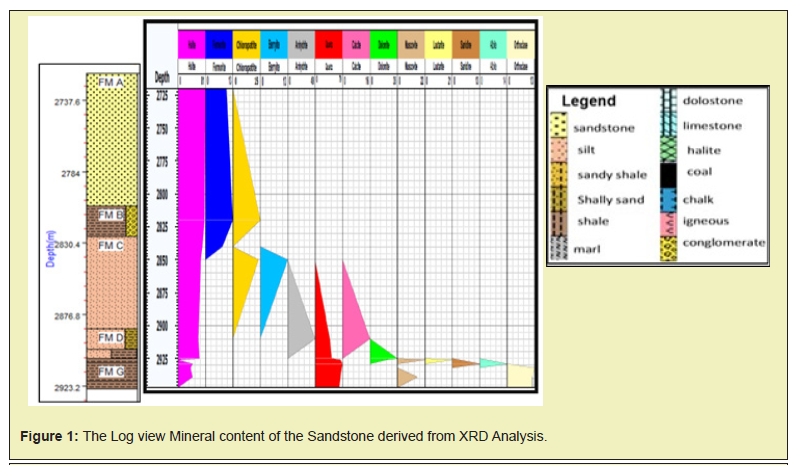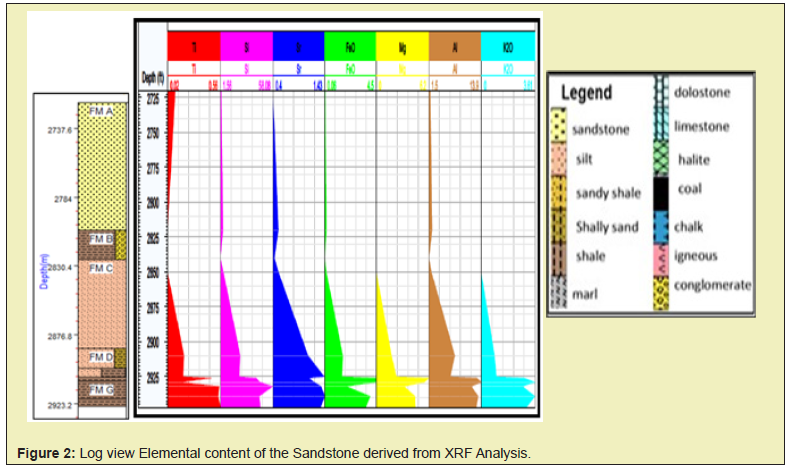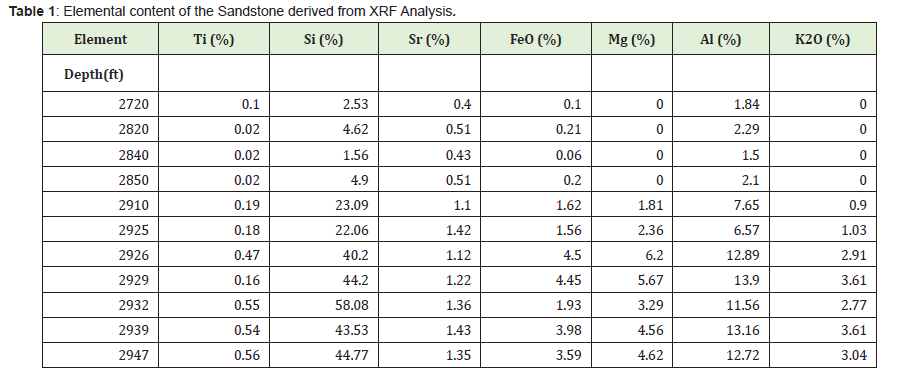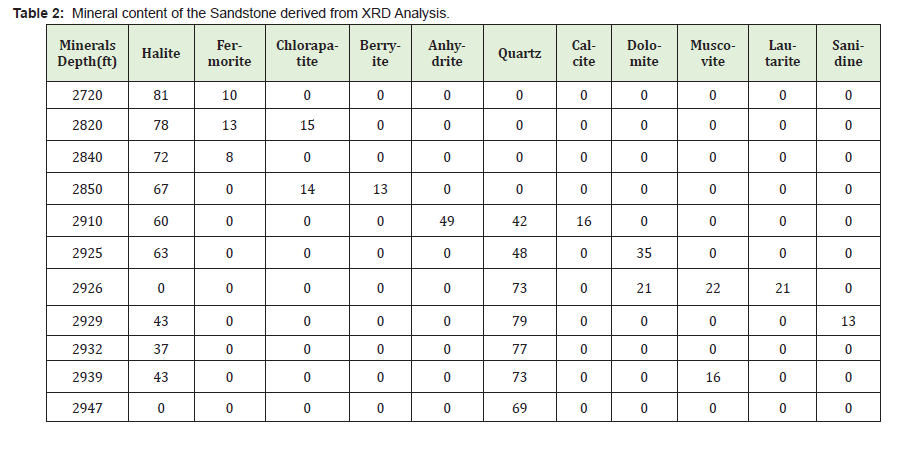In a bid to evaluate the elemental and mineralogical content of reservoir samples from the “X” well in the “Y” oil field offshore Southern Gabon, analyses were performed using XRD and XRF. The log view profile of the result inferred that Na, Mg, and Calcite were absent in the shallower series of the reservoir sandstones studied, this observation implies that they are soluble ions that had eroded and refer to warm and humid paleoclimate and a depositional environment that is arid, which corresponds to the continental crust as their source. The plot of Ti and FeO+Mg discriminate the deeper series of the reservoir sandstone samples from the shallower samples. The lower series showed heavier values which implies their origin from Oceanic Crust. These are also the pre-salt facies while the shallower series were more of continental origin and represent the post-salt facies.
Keywords: Elemental profile, Gabon, Mineralogical profile, Provenance, Paleoclimate
Chemo stratigraphy is the study of the use of elemental and mineralogical composition to delineate the sequence of deposition of formations, this helps in establishing stratigraphic relationships.1 This information could also be used in delineating the provenance, maturity, and class of the sediments. The chemo stratigraphic profile can also be used in understanding reservoir functionality with respect to the group of minerals that may be present in reservoir sand bodies.2 Scales are also important compounds but regarding flow assurance in the context of gathering etc. Provenance represents the source of the sediments, which may be continental crust or oceanic crust. The paleoclimate of the sediments expresses the weathering tendency of the sediments. This study can also be applied to generate the geochemical fingerprint of a sequence of formations. The study can also be applied in establishing chemo stratigraphic zones. The study can also provide for correlation studies between reservoir sand bodies.
Geology of the study area
The geology of Gabon is centered on the opening of the Southern Atlantic, which gave rise to a series of horst and graben which consist of the Gabon basin. The Gabon basin consists of the North, Interior, and the South. The sedimentary fill of the basin is divided into Pre-rift, Syn-rift, and Post-rift.3,4 The Interior basin consists mostly of Pre-rift sediments and it consists of continental, fluviatile, and lacustrine sediments. The post-rift sediments are found in the North and South basins and are continental, fluvial, and lagoonal. The North and South basins are mostly Offshore basins. The Gabon basin has two prominent sandstone formations which are the Gamba Formation in the Offshore and the Dentale Formation in the Shallow waters.
Sampling and sample preparations
Materials and methods encompass the materials and methods that were employed in the course of this study reservoir samples were obtained from the reservoir section of well X in Field Y offshore Southern Gabon. Samples were obtained between the depths of 2720m to 2947m which were 14 (fourteen) in number, however, 11 (eleven) samples were chosen for analysis, the basis was that these were sandstones since the particular reference was to the reservoir section. The samples were prepared by cleaning and removing the carvings, after which it was pulverized. The analysis of samples was performed using XRD and XRF for the mineral and elemental composition, the model of the X-ray fluorescence Spectrometer is Spectro XEPOS, produced by AMETEK, with an autosampler with 12 situations for tests and a 50watt end window X–beam cylinder to invigorate the examples. The software for data handling is X–LabPro5.1.
The results of the study are presented as a log view of the depth range of the well alongside its descriptive lithology. Graphical expressions have also been used to unravel relationships that portray the provenance of weathering and paleoclimate.
The log view profiles
Mineralogical profile
The log view for the mineralogical profile indicates that halite is the most abundant throughout the studied depth range, but more pronounced within the sandstones, however, it reduces downdip. The second most abundant mineral is femonite which also occurs within the sandstone unit. Chlorapatite is the third most abundant occurring within the sandstone and slit units. Other minerals such as Quartz, Calcite, dolomite, muscovite Albite, and Orthoclase were absent in the sandstone unit but present in the shaly zone. The absence of these minerals in the sandstone unit infers they may have been dissolved/eroded, indicating that the sandstone unit has been exposed to wet paleoclimate.2,5 The halite profile could infer that the deeper reservoir sandstone could be pre-salt, while the shallower facies could be syn-salt or post-salt deposits. The geology of Gabon presents that a salt layer separates the continental facies from the marine facies.3
The elemental profile
The elemental profile showed the complete absence of K2O and Mg relative to Al, FeO, Sr, Si, and Ti in the sandstone unit. This observation infers that the sandstone unit had been weathered.2,6
Weathering and paleoclimate
The absence of K, Mg muscovite, quartz, and calcite in the sandstone units reveals that weathering occurred given that larger cations will be recalcitrant to weathering, unlike Na and K with smaller cations which will be easily removed from the weathering matrix.1,2 Chemical weathering such as observed, is dominant in a warm and humid environment which portrays the paleoclimate, and the environment of deposition is inferred to be arid.
Provenance
The provenance infers the source of the sandstone body, sediments are normally weathered and then transported to the site of deposition, sediment could be described as Mafic (magnesium and iron-rich) or felsic (Feldspar and silicon-rich). Mafic sediments are mostly sourced from Oceanic Crust while Felsic sediments are mostly sourced from continental Crust.1,2,7
The plot of Ti and Fe+Mg Figure 3 has always been employed in discriminating Felsic from Mafic sandstones which are normally high-density sandstones.5
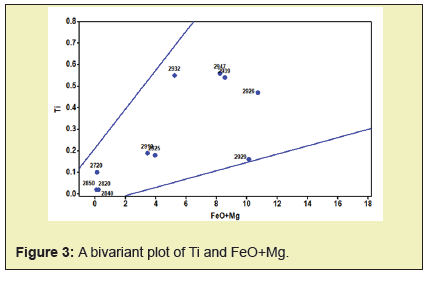
The plot of Ti and FeO+Mg in Figure 3 shows that the shallower sandstone series (2730m to 2850m) have very low Ti and FeO+Mg contents while the deeper series (2910m–2929m) show higher values. This observation could be inferred to portray that deeper sandstone facies have a slightly higher content of Oceanic crust-sourced sediments.8-11
The elemental and mineralogical logview profile showed that the shallower series of the sandstone had no significant presence of K, Ca, and Mg which correspond to the soluble ions and imply warm and humid paleoclimate, and the environment of deposition is inferred to be arid. An arid environment corresponds to a continental crust. The plot of Ti and FeO+Mg discriminate the deeper series of the sandstone from the shallower series, the deeper series is heavier and infers Oceanic facies and also presalt facies, while the shallower series are more continental in origin and represent post salt facies.
We acknowledge the support received from the Geology Department, University of Port Harcourt, Nigeria.
None.
We, as authors, declare that there is no conflict of interest in this work.
- 1. Ramkumar M. Chemostratigraphy; Concepts, Techniques, and Applications. 1st (edn). Amsterdam, Netherlands: Elsevier. 2015;pp.651.
- 2. Craigie N. Principles of Elemental Chemostratigraphy; A Practical User Guide. 1st (edn). Cham, Switzerland: Springer International Publishing. 2018;pp.342.
- 3. Brink AH. Petroleum Geology of Gabon Basin. The American Association of Petroleum Geologists Bulletin. 1974;58(2):216-235.
- 4. Teisserenc P, Villemin J. Sedimentary basin of Gabon geology and oil systems”. In: J. D. Edwards & P. A. Santogrossi, eds. Divergent/passive margin basins. Tulsa: AAPG. 1990;pp.117–199.
- 5. Alexandre P. Practical Geochemistry. 1st (edn). Switzerland: Springer Nature, 2021;pp.531.
- 6. Craigie NW. Application of chemostratigraphy in Middle Jurassic and Unconventional reservoir in Eastern Saudi Arabia. GeoArabia. 2015;20(2):79–110.
- 7. Pearce J, Nigel Harris N, Tindle AG. Trace Element Discrimination Diagrams for the Tectonic Interpretation of Granitic Rocks. Journal of Petrology. 1984;25:956–983.
- 8. Hu X, Hu S, Jin Fm, et al. Physics of Petroleum Reservoirs. Beijing, China: Petroleum Industry Press. 2017;pp.278.
- 9. Prochnow EA. Organic-Inorganic interactions in oilfield sandstones": examples from "Turbidite reservoirs in the Campos Basin, Offshore Eastern Brazil. Journal of Petroleum Geology. 2006;pp.361-380.
- 10. Slatt RM. Stratigraphic reservoir characterization For petroleum geologists, Geophysicst and Engineers. Amsterdam, The Netherlands: Elsevier. 2006;pp.421.
- 11. Welton JE. SEM Petrology Atlas. 2nd (edn). Tulsa, Oklahoma: The American Association of Petroleum Geologists. 2003;pp.134.


